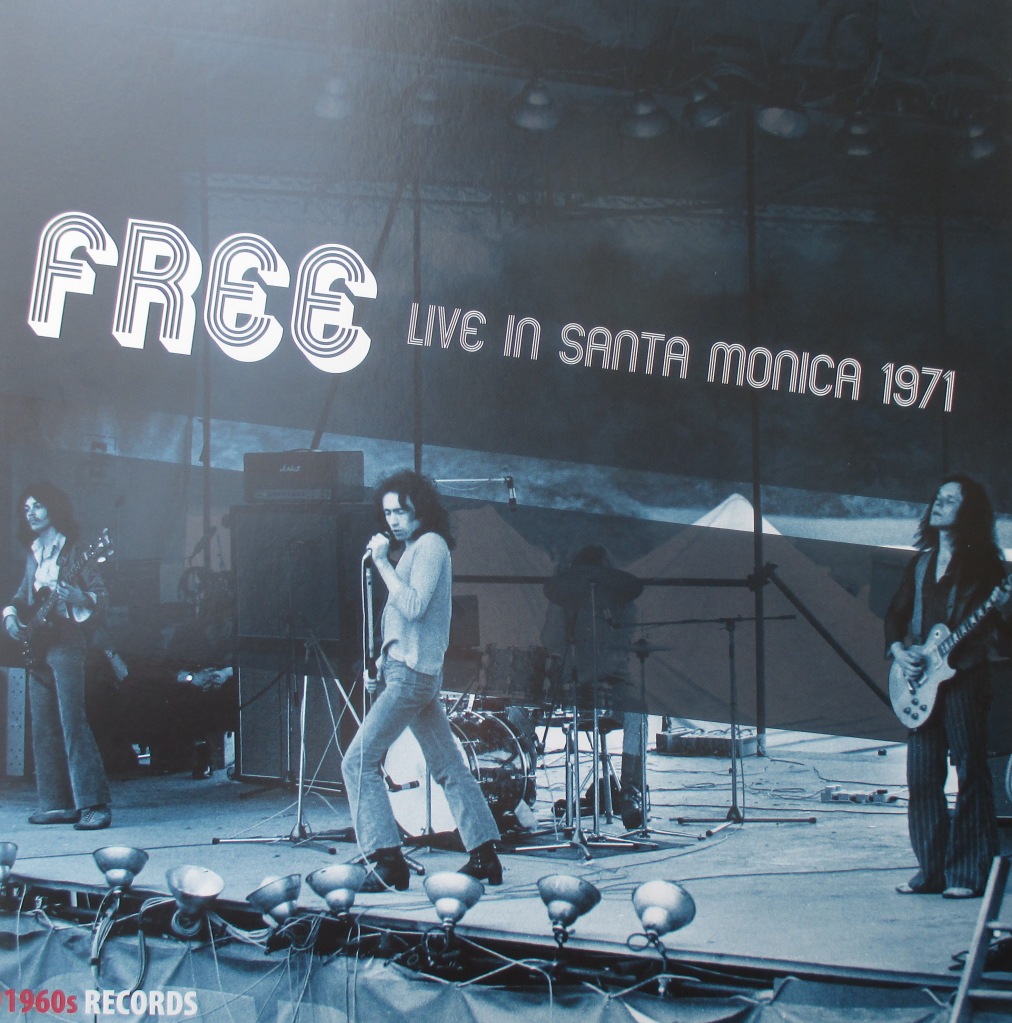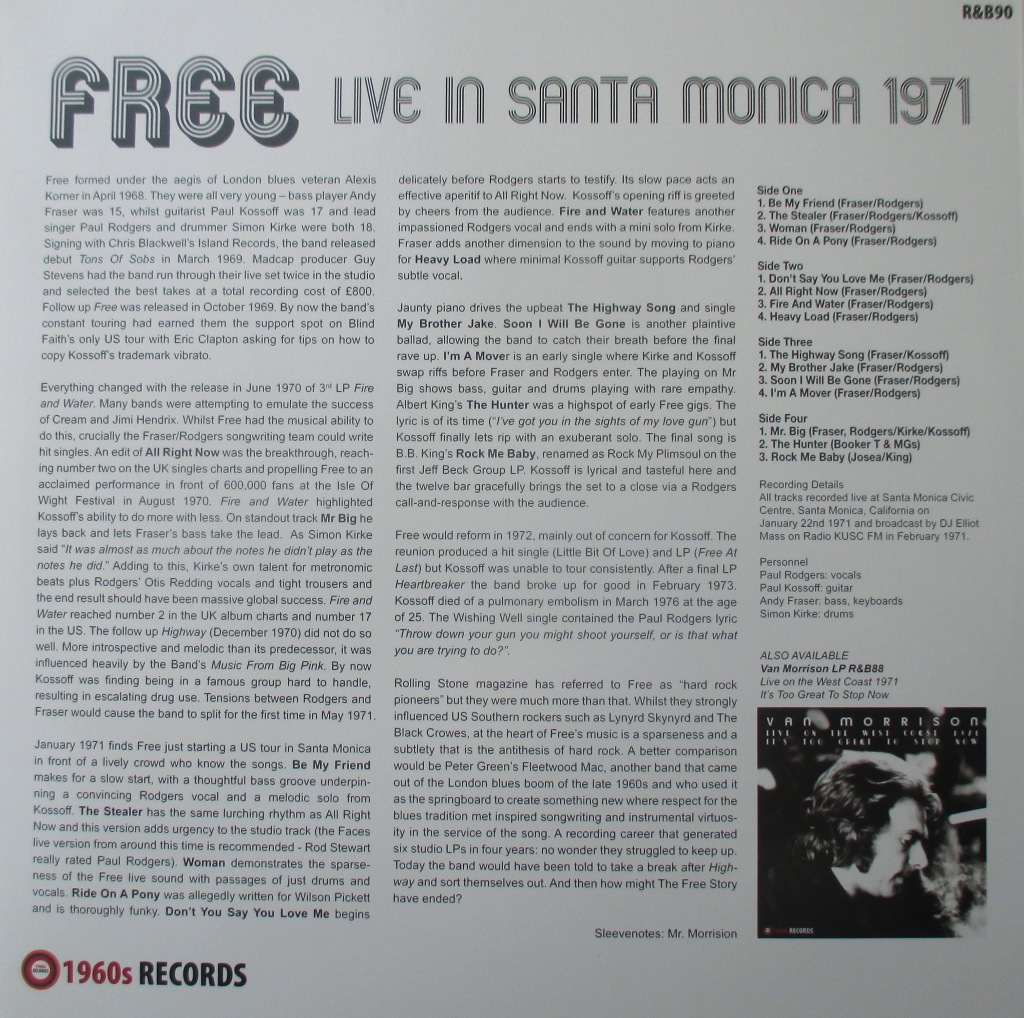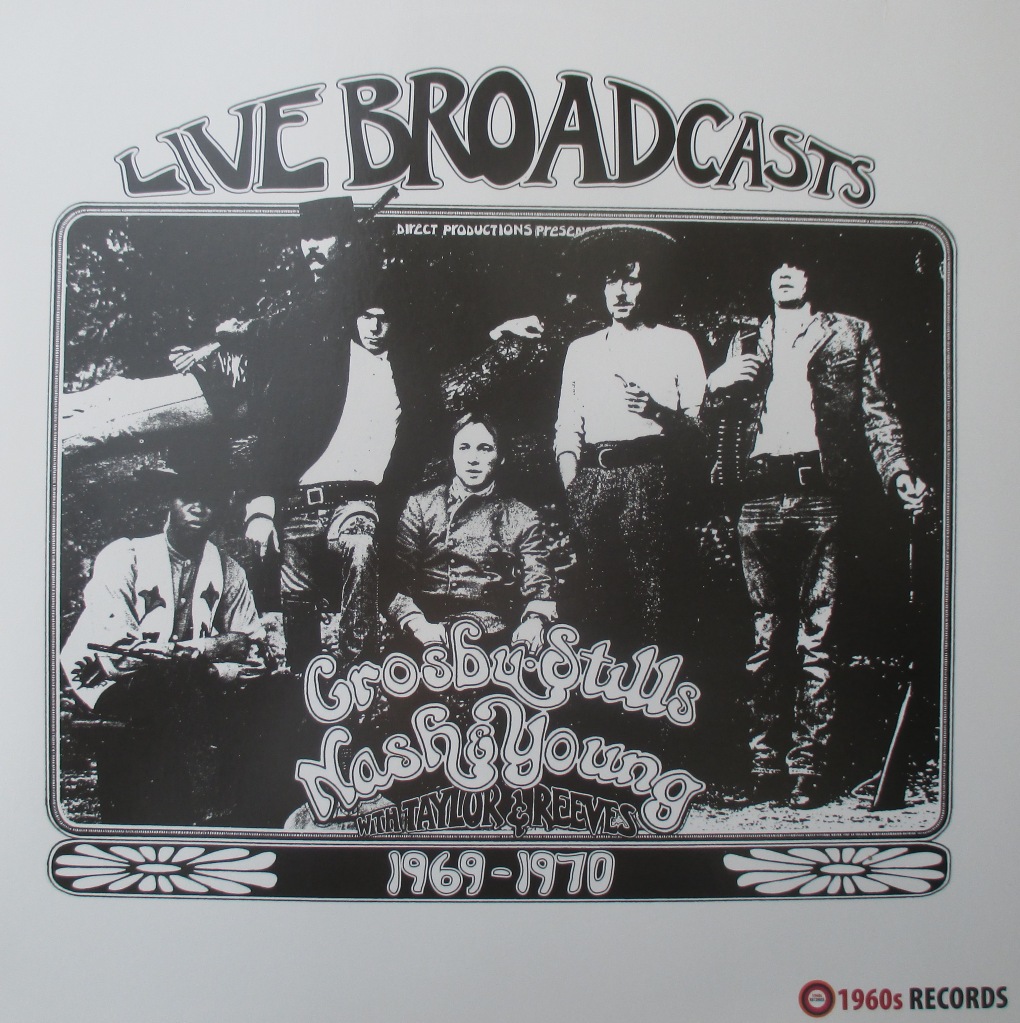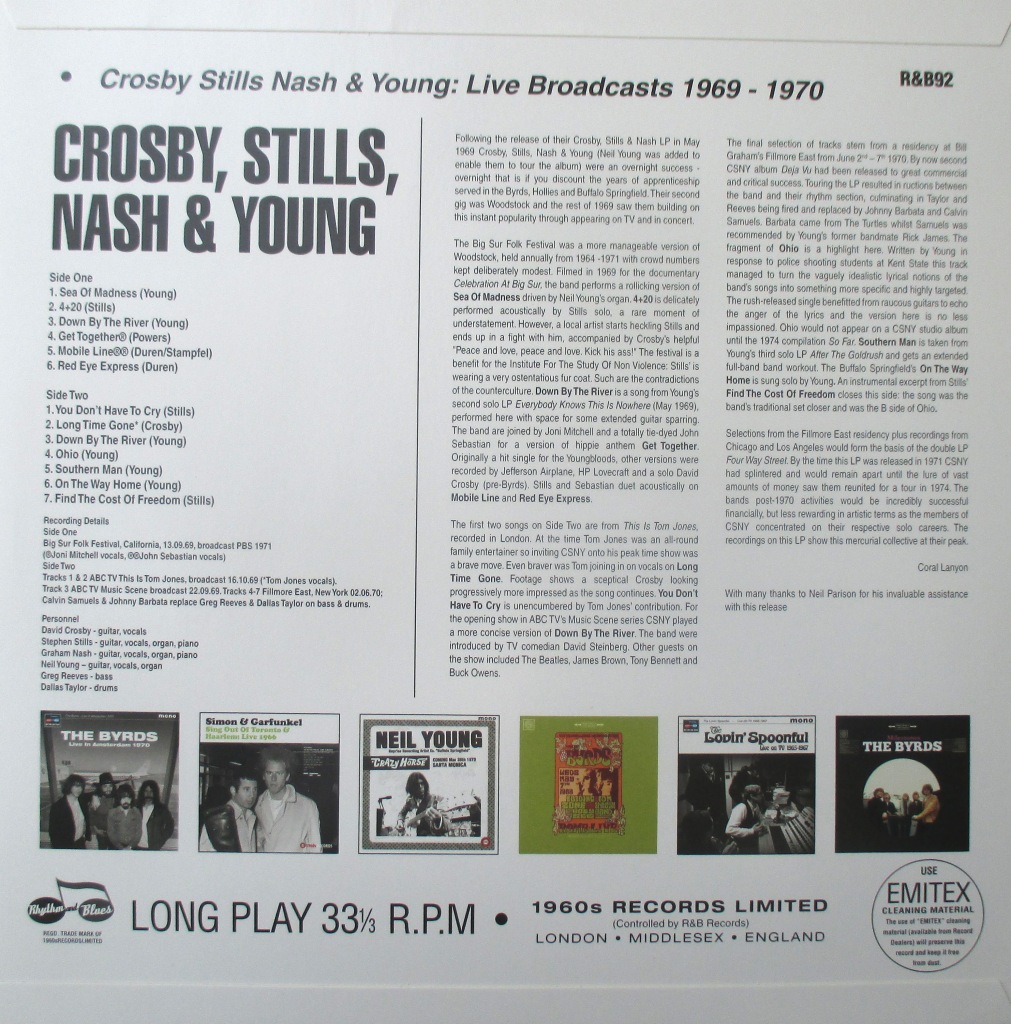Free, Crosby Stills Nash & Young New LPs
Available now from http://www.1960s.london

Free – Live In Santa Monica 1971
Side One
1. Be My Friend (Fraser, Rodgers)
2. The Stealer (Fraser, Rodgers, Kossoff)
3. Woman (Fraser, Rodgers)
4. Ride On A Pony (Fraser, Rodgers)
Side Two
- Don’t Say You Love Me (Fraser, Rodgers)
- All Right Now (Fraser, Rodgers)
- Fire And Water (Fraser, Rodgers)
- Heavy Load (Fraser, Rodgers)
Side Three
1. The Highway Song (Fraser, Kossoff)
2. My Brother Jake (Fraser, Rodgers)
3. Soon I Will Be Gone (Fraser, Rodgers)
4. I’m A Mover (Fraser, Rodgers)
Side Four
1. Mr. Big (Fraser, Rodgers, Kirke, Kossoff)
2. The Hunter (Jones, Wells, Dunn, Jackson, Cropper)
3. Rock Me Baby (Josea, King)
Recording Details
All tracks recorded live at Santa Monica Civic Centre, Santa Monica, California on
January 22nd 1971 and broadcast by DJ Elliot Mass on Radio KUSC FM in February 1971.
Personnel
Paul Rodgers: vocals
Paul Kossoff: guitar
Andy Fraser: bass, keyboards
Simon Kirke: drums

Sleevenotes
Free formed under the aegis of London blues veteran Alexis Korner in April 1968. They were all very young – bass player Andy Fraser was 15, whilst guitarist Paul Kossoff was 17 and lead singer Paul Rodgers and drummer Simon Kirke were both 18. Signing with Chris Blackwell’s Island Records, the band released debut Tons Of Sobs in March 1969. Madcap producer Guy Stevens had the band run through their live set twice in the studio and selected the best takes at a total recording cost of £800. Follow up Free was released in October 1969. By now the band’s constant touring had earned them the support spot on Blind Faith’s only US tour with Eric Clapton asking for tips on how to copy Kossoff’s trademark vibrato.
Everything changed with the release in June 1970 of 3rd LP Fire and Water. Many bands were attempting to emulate the success of Cream and Jimi Hendrix. Whilst Free had the musical ability to do this, crucially the Fraser/Rodgers songwriting team could write hit singles. An edit of All Right Now was the breakthrough, reaching number two on the UK singles charts and propelling Free to an acclaimed performance in front of 600,000 fans at the Isle Of Wight Festival in August 1970. Fire and Water highlighted Kossoff’s ability to do more with less. On standout track Mr Big he lays back and lets Fraser’s bass take the lead. As Simon Kirke said “It was almost as much about the notes he didn’t play as the notes he did.” Adding to this, Kirke’s own talent for metronomic beats plus Rodgers’ Otis Redding vocals and tight trousers and the end result should have been massive global success. Fire and Water reached number 2 in the UK album charts and number 17 in the US. The follow up Highway (December 1970) did not do so well. More introspective and melodic than its predecessor, it was influenced heavily by the Band’s Music From Big Pink. By now Kossoff was finding being in a famous group hard to handle, resulting in escalating drug use. Tensions between Rodgers and Fraser would cause the band to split for the first time in May 1971.
January 1971 finds Free just starting a US tour in Santa Monica in front of a lively crowd who know the songs. Be My Friend makes for a slow start, with a thoughtful bass groove underpinning a convincing Rodgers vocal and a melodic solo from Kossoff. The Stealer has the same lurching rhythm as All Right Now and this version adds urgency to the studio track: the Faces live version from around this time is recommended – Rod Stewart really rated Paul Rodgers. Woman demonstrates the sparseness of the Free live sound with passages of just drums and vocals. Ride On A Pony was allegedly written for Wilson Pickett and is thoroughly funky. Don’t You Say You Love Me begins delicately before Rodgers starts to testify. Its slow pace acts an effective aperitif to All Right Now. Kossoff’s opening riff is greeted by cheers from the audience. Fire and Water features another impassioned Rodgers vocal and ends with a mini solo from Kirke. Fraser adds another dimension to the sound by moving to piano for Heavy Load where minimal Kossoff guitar supports Rodgers’ subtle vocal.
Jaunty piano drives the upbeat The Highway Song and single My Brother Jake. Soon I Will Be Gone is another plaintive ballad, allowing the band to catch their breath before the final rave up. I’m A Mover is an early single where Kirke and Kossoff swap riffs before Fraser and Rodgers enter. The playing on Mr Big shows bass, guitar and drums playing with rare empathy. Albert King’s The Hunter was a highspot of early Free gigs. The lyric is of its time (“I’ve got you in the sights of my love gun”) but Kossoff finally lets rip with an exuberant solo. The final song is B.B. King’s Rock Me Baby, renamed as Rock My Plimsoul on the first Jeff Beck Group LP. Kossoff is lyrical and tasteful here and the twelve bar gracefully brings the set to a close via a Rodgers call-and-response with the audience.
Free would reform in 1972, mainly out of concern for Kossoff. The reunion produced a hit single (Little Bit Of Love) and LP (Free At Last) but Kossoff was unable to tour consistently. After a final LP Heartbreaker the band broke up for good in February 1973. Kossoff died of a pulmonary embolism in March 1976 at the age of 25. The Wishing Well single contained the Paul Rodgers lyric “Throw down your gun you might shoot yourself, or is that what you are trying to do?”.
Rolling Stone magazine has referred to Free as “hard rock pioneers” but they were much more than that. Whilst they strongly influenced US Southern rockers such as Lynyrd Skynyrd and The Black Crowes, at the heart of Free’s music is a sparseness and a subtlety that is the antithesis of hard rock. A better comparison would be Peter Green’s Fleetwood Mac, another band that came out of the London blues boom of the late 1960s and who used it as the springboard to create something new where respect for the blues tradition met inspired songwriting and instrumental virtuosity in the service of the song. A recording career that generated six studio LPs in four years: no wonder they struggled to keep up. Today the band would have been told to take a break after Highway and sort themselves out. And then how might The Free Story have ended?
Sleevenotes: Mr. Morrision
PLEASE NOTE
Owing to a manufacturing error the second disc of this 2LP set is labelled incorrectly. The music however is as per the tracklisting. Apologies for the mistake.

Crosby Stills Nash & Young: Live 1969 – 1970
Side One
- Sea Of Madness (Young)
- 4+20 (Stills)
- Down By The River (Young)
- Get Together (Powers)
- Mobile Line (Duren, Stampfel)
- Red Eye Express (Duren)
Side Two
- You Don’t Have To Cry (Stills)
- Long Time Gone (Crosby)
- Down By The River (Young)
- Ohio (Young)
- Southern Man (Young)
- On The Way Home (Young)
- Find The Cost Of Freedom (Stills)
Recording Details
Side One
Tracks 1-6 recorded at the Big Sur Folk Festival in the grounds of the Salen Institute, California, September 13th -14th 1969 and included in the film Celebration At Big Sur
Side Two
Tracks 1 & 2 Recorded for This Is Tom Jones, ATV Television, broadcast October 16th 1969
Track 3 Recorded live for ABC TV Music Scene and broadcast on September 22nd 1969
Tracks 4 – 7 recorded live at the Fillmore East, New York June 2nd 1970 and broadcast on VH-1 Legends Specials March 12th and June 15th 2000
Personnel
Side One – tracks 1-4, Side Two tracks 1 -3
Neil Young – guitar, vocals, organ
Stephen Stills – guitar, vocals, organ, piano
David Crosby – guitar, vocals
Graham Nash – guitar, vocals, organ, piano
Dallas Taylor – drums
Greg Reeves – bass
Joni Mitchell – guitar, vocals (Side one, Track 4)
John Sebastian – vocals (Side one, Track 4)
Tom Jones – vocals (Side 2, Track 2)
Side One – tracks 5 & 6
Stephen Stills – guitar, vocals
John Sebastian – guitar, vocals
Side Two tracks 4-7
Neil Young – guitar, vocals, organ
Stephen Stills – guitar, vocals, organ, piano
David Crosby – guitar, vocals
Graham Nash – guitar, vocals, organ, piano
John Barbata – drums
Calvin Samuels – bass
Sleevenotes
Following the release of their eponymous LP in May 1969 Crosby, Stills, Nash & Young were an overnight success – overnight that is if you discount the years of apprenticeship served in the Byrds, Hollies and Buffalo Springfield. Their second gig was Woodstock and the rest of 1969 saw them building on this instant popularity through appearing on TV and in concert.
The Big Sur Folk Festival was a more manageable version of Woodstock, held annually from 1964 -1971 with crowd numbers kept deliberately modest. Filmed in 1969 for the documentary Celebration At Big Sur, the band performs a rollicking version of’ Sea Of Madness driven by Neil Young’s organ. 4+20 is delicately performed acoustically by Stills solo, a rare moment of understatement. However a local artist starts heckling Stills and ends up in a fight with him, accompanied by Crosby’s helpful “Peace and love, peace and love. Kick his ass!”. The festival is a benefit for the Institute For The Study Of Non Violence: Stills’ is wearing a very ostentatious fur coat. Such are the contradictions of the counterculture. Down By The River is a song from Young’s second solo LP Everybody Knows This Is Nowhere (May 1969), performed here with space for some extended guitar sparring. The band are joined by Joni Mitchell and a totally tie-dyed John Sebastian for a version of hippie anthem Get Together. Originally a hit single for the Youngbloods, other versions were recorded by Jefferson Airplane, HP Lovecraft and a solo David Crosby (pre-Byrds). Stills and Sebastian duet acoustically on Mobile Line and Red Eye Express.
The first two songs on Side Two are from This Is Tom Jones, recorded in London. At the time Tom Jones was an all-round family entertainer so inviting CSNY onto his peak time show was a brave move. Even braver was Tom joining in on vocals on Long Time Gone. Footage shows a sceptical Crosby looking progressively more impressed as the song continues. You Don’t Have To Cry is unencumbered by Tom Jones’ contribution. For the opening show in ABC TV’s Music Scene series CSNY played a more concise version of Down By The River. The band were introduced by TV comedian David Steinberg. Other guests on the show included The Beatles, James Brown, Tony Bennett and Buck Owens.
The final selection of tracks stem from a residency at Bill Graham’s Fillmore East from June 2nd – 7th 1970. By now second CSNY album Deja Vu had been released to great commercial and critical success. Touring the LP resulted in ructions between the band and their rhythm section, culminating in Taylor and Reeves being fired and replaced by Johnny Barbata and Calvin Samuels. Barbata came from The Turtles whilst Samuels was recommended by Young’s former bandmate Rick James. The fragment of Ohio is a highlight here. Written by Young in response to police shooting students at Kent State this track managed to turn the vaguely idealistic lyrical notions of the band’s songs into something more specific and highly targeted. The rush-released single benefitted from raucous guitars to echo the anger of the lyrics and the version here is no less impassioned. Ohio would not appear on a CSNY studio album until the 1974 compilation So Far. Southern Man is taken from Young’s third solo LP After The Goldrush and gets an extended full-band band workout. The Buffalo Springfield’s On The Way Home is sung solo by Young. An excerpt fromStills’ Find The Cost Of Freedom closes this side:the songwas the band’s traditional set closer and was the B side of Ohio.
Selections from the Fillmore East residency plus recordings from Chicago and Los Angeles would form the basis of the double LP Four Way Street. By the time this LP was released in 1971 CSNY had splintered and would remain apart until the lure of vast amounts of money saw them reunited for a tour in 1974. The bands post-1970 activities would be incredibly successful financially, but less rewarding in artistic terms as the members of CSNY concentrated on their respective solo careers. The recordings on this LP show this mercurial collective at their peak.
Coral Lanyon
With many thanks to Neil Parison for his invaluable assistance with this release

